Walking 100,000 Mountains in Hunan and Guizhou
Every summer vacation, I travel by car. This year's summer vacation destinations are Hunan and Guizhou. Depart from Ningbo at 6 a.m. on July 27, 2018, drive 1200 kilometers a long distance, and stay and rest in Xinhua, Hunan at night.
Fenghuang ancient city
The border city in western Hunan in Shen Congwen's novel "Border Town", the crystal clear river, the small city surrounded by water and mountains, and the hanging buildings on the river street are always fascinating. After the special stamps of "Phoenix Ancient City" were issued in 2009, Yang Wenqing, who designed this set of stamps, helped me draw a set of hand-painted envelopes of "Phoenix Ancient City" with exquisite meticulous painting techniques (Figures 1-3), which captured the beautiful scenery of this famous historical and cultural city in China. Freeze on the envelope. I often take it out to enjoy it, which reminds me of my desire to visit Phoenix and stamp the hand-painted envelope with the original postmark.

On the morning of the 28th, we drove into the ancient city of Fenghuang, walked through the ancient road on the bank of the Tuojiang River, walked through the jumping rocks on the Tuojiang River to the North Gate Tower on the other side. At both ends of the ancient city building are built with purple-red sand and gravel walls along the river bank. The city wall has two towers, east and north. It has experienced many vicissitudes and is still elegant and majestic. The river beside the city wall is very shallow, the water flows slowly and gently, and you can see the swaying water and grass in the soft waves. We turned back from the wooden stone bridge next to it and browsed the beautiful scenery on both sides of the river back and forth.



There is a Monkey Jump Post Office in the attic near Hongqiao (Figure 4). I sent some postcards here, but the postmark showed the Love Post Office (Figure 5). The Hongqiao Bridge was built in the Ming Dynasty, and most of the monuments below the bridge deck are Ming Dynasty monuments. The craftsmen who built the bridge worked meticulously at that time, and the bridge stands still today. Walking forward on Hongqiao, a picture of the Jiangnan water town is displayed in front of you: Wanshou Palace, Wanming Tower, Duicui Tower... a feeling of being away from the world comes leisurely. On both sides of the Hongqiao River, there are rows of pendulous buildings, standing on the water, with thin and long wooden legs extending into the river, and behind them are green mountains. They have strong Miao architectural characteristics (Figure 6). Across Hongqiao is the ancient street. On both sides are buildings with unique phoenix characteristics. The ancient street is covered with red lanterns, which is quite festive.



Zhenyuan ancient city
After coming out of Phoenix, I drove to Zhenyuan, the "Gateway to East Guizhou", and stayed at the Riverside Inn in Zhenyuan at night. The bright lights on both sides of the Wuyang River and the sparkling lights and shadows on the water complement each other, making the thousand-year-old town extraordinarily enchanting.
I climbed Shiping Mountain on the morning of the 29th, and the mountain was shrouded in clouds and mist in the morning. The Great Wall of Miao Xinjiang is entrenched on the mountain. Looking down from Shiping Mountain, the Wuyang River meanders through the city in an "S" shape. The north bank is the old Fucheng City, and the south bank is the old Acropolis. From a distance, it looks like a Tai Chi diagram. Zhenyuan City surrounded by mountains. Not far down the mountain is the Qinglongdong ancient building complex that once appeared on the postage postcard of "Guizhou Scenery"(Figure 7). The whole group of buildings is backed by mountains and rivers, cliffs and caves, close to walls and high in the sky, and is scheming. It is well organized and is known as the "Southwest Hanging Temple". Looking across the river from the Diaojiao Tower, the water surface is rippling with green ripples and clear as jade (Figure 8).
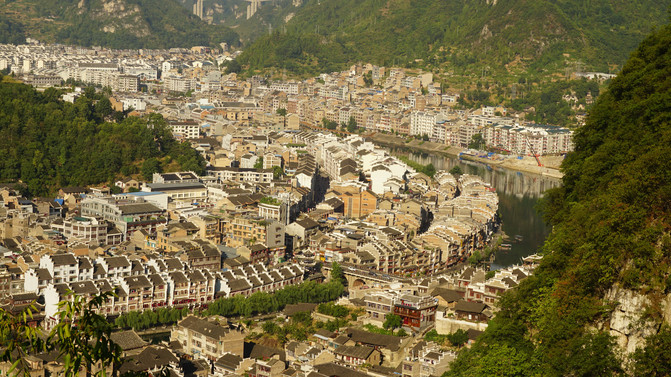
Xijiang qianhu Miao village
After lunch, go to Xijiang Qianhu Miao Village. Live in the "Story Inn" near the Miaozhai Observation Deck. When the lanterns first come on, the lights of thousands of homes overlooking Miao Village from the observation deck of the inn are like stars scattered on the mountains.

On the morning of the 30th, I took a bus from the scenic area to Miao Village. It is surrounded by mountains and lush mountains. A stream comes from Leigongping and passes through the village. Five wind and rain bridges span the stream, wooden pendants are built against the mountains, and the dark red maple wooden boards are golden in the sun, which is quite spectacular. There is a post office with the theme of Chinese Miao culture in Miao Village (Figure 9), and even the mailbox placed at the door is in the shape of a drum king in Miao Village. There are postcards with Miao customs for sale, and there are many scenic postmarks for tourists to stamp. I sent a batch of postcards and hand-painted envelopes to my friends (Figures 10, 11, 12). After enjoying the strong Miao style performance in the village (Figure 13), bid farewell to the Miao village and head for Libo.




Libo
Libo is hidden deep in the mountains of southern Qiannan, with excellent mountains and rivers and is known as a secret realm in the world. On July 31, we entered from the west gate of Xiaoqikong. Not far away is Wolong Waterfall. Further forward is Yuanyang Lake (Figure 14), which once appeared on the postage postcard of "Guizhou Scenery". Yuanyang Lake is a natural lake. It is connected by two large and small lakes. There is a "tree-lined forest on the water" about 700 meters long between the large and small lakes, with beautiful wooden branches forming sheds on both sides. The lake area is densely shaded, and waterbirds echo each other, making it quiet and deep. Board a boat into the lake and paddle along the winding lake water in the woods. The colors of the lake water vary, including red, orange, yellow, green, blue, and purple. Looking around the lake, the verdant trees are leaning towards the lake, reflecting the color of the trees in the water, turning it into a colorful lake. Looking far into the shore, you can see thick shadows and waterbirds calling each other. The realm is secluded. Being in it is like a fairyland. Then we went to Tianzhong Cave, where the acid calcium deposits included stalactites, stalagmites, stone pillars, stone shields, cave beads, flowing stones, etc. The most characteristic thing was the stalactites upside down on the ground like a copper bell. Out of the cave and down the mountain, walk from the water forest, 68-level waterfall, and Raya Waterfall to the Xiaoqikong Bridge. This is a world of water, with layers of waterfalls pouring down, some pouring pearls and jade, pushing snow and embracing clouds, or flowing like a river, like a galaxy pouring down the ground, with various shapes and myriad phenomena. The small seven-hole stone bridge is made of hemp stone strips. The bridge body is covered with vines and ferns. Under the bridge is an intoxicating green Hanbi Pool (Figure 15). Ancient trees on both sides reach the sky, and huge willow branches stretch along the bridge. Arms, like a giant umbrella supported on the bridge. Unfortunately, there is no post office in the scenic area, so no postal traces can be left.

After dinner, I drove to Huangguoshu and checked into Wanjia Hotel near Huangguoshu. It was already very late.
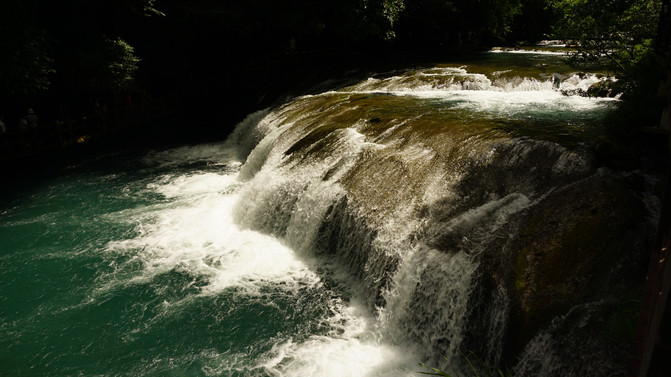



huangguoshu
Huangguoshu Waterfall is the largest waterfall in Asia. The main attractions in the scenic area include the Great Waterfall, Doudou Pond, Tianxing Bridge, etc. Among them, the Great Waterfall, Doudou Pond, Silver Chain Pendant, and Dishuitan Waterfall are all on the national business cards.
On the morning of August 1, everyone felt tired, so they slept more. It was already past eight o'clock when they got up. The enthusiastic restaurant owner told us that the Great Falls are crowded with people every day, especially the Shuilian Cave. It is suggested that we go to visit Tianxing Bridge and Doudoutang Scenic Area first today. He will drive a private car to take us into the Great Waterfall Scenic Area early tomorrow morning, so as to avoid the crowded crowd.


Tianxing Bridge is a karst landform park. The entire scenic area has wonderful mountains and rivers and trees, like a natural bonsai garden. Crossing Tianxing Bridge and exiting Tianxing Cave is the Maoshuitan, with the ups and downs of the river bed forming many small waterfalls. Then there is the Silver Chain Falling Waterfall. After the small waterfalls in the upper reaches merge, the water flows lightly along the rough surface of the boulder, spreads evenly, and then slowly gathers in the deep pool at the bottom, like thousands of silver chains of large and small falling softly into the deep pool. Under the sun, the water seems to be covered with a layer of silver gauze. It is crystal clear, clear and gentle, giving people the illusion of accidentally falling into the Milky Way and reluctant to leave (Figure 16).

Come out of Tianxing Bridge Scenic Area and go to Doudou Pond. Doudoutang Waterfall is located 1 kilometer upstream of Huangguoshu Waterfall. The waterfall top is 105 meters wide and 27 meters high. It is the widest waterfall among the Huangguoshu Waterfalls. In the evening, tourists dispersed one after another, and the scenic area that had been a busy day slowly became empty. The sunset shone on the waterfalls, and the waterfalls glowed slightly with white light. Doubotang Waterfall shows its gentle side (Figure 17).
On the 2nd, get up early. The boss drove us into the scenic area before dawn. Climbing down the stairs from the dense mountains and forests, the sky gradually became brighter. The trees on both sides of the mountain road grow lush in the humid environment. Not far after walking, you can see through the treetops the great waterfall hanging on the cliff ahead like white. Arriving at the Waterfall Pavilion standing in the sky, leaning against the pavilion railing, I saw the waterfall pouring down from the cliff more than 60 meters high and falling into the Rhinoceros Pond, stirring up waves to surge into the sky, raising layers of mist in the wind, filling the valley. It is quite spectacular as "white shadows floating in the sky, and cold sounds falling in the sky." Follow the rugged and wet mountain path to the Water Curtain Cave behind the waterfall. The layers of water outside the cave are like thousands of arrows shooting at the same time, and the sound of waterfalls is like thunder. When you come out of the Shuishilian Cave and go to the Rhinoceros Pond, you can see the great waterfall, Rhinoceros Pond, the bamboo forests, vegetation, etc. organically combined into a spectacular and dynamic three-dimensional landscape painting (Figure 18). It is not difficult to understand that the Huangguoshu Waterfall on the ordinary stamps and postage postcards of "Scenery of the Motherland" are filmed here. I arrived at the Huangguoshu Waterfall themed post office at the entrance of the scenic area at 9 o'clock (Figure 19), but the door was closed. The owner of the nearby specialty store picked up his mobile phone to help me contact me. It turned out that the salesperson was stuck in a traffic jam and waited until 9:30 before the salesperson hurried. Quickly stamp the hand-painted seal you brought with you (Figures 20 and 21).



Dishuitan Waterfall was seen on the Baling River Bridge when returning from Xingyi. In the valley, Dishuitan Waterfall fell from the sky, and a mist rose into the sky at the bottom of the valley. Although you look from a distance, you can still feel the power of it rushing straight into the canyon with the power of thunder.
Xingyi
Drive to Xingyi, and in the afternoon to the Maling River Grand Canyon, known as the most beautiful scar on earth. The scenic spot is famous for its peaks and valleys, hanging waterfalls, and calcium carbonate wall hanging. Waterfalls and the sun reflect each other. The calcified waterfalls have the most peculiar landscape. They have deep valleys, rapid flows, many waterfalls, and complete protection of the original ecology. There are so many exquisite rock paintings, which constitute the "strange cracks in the southwest and the wonders of the world." When I went out, I sent several hand-painted envelopes (Figure 22) to the theme post office at the entrance of the scenic area.

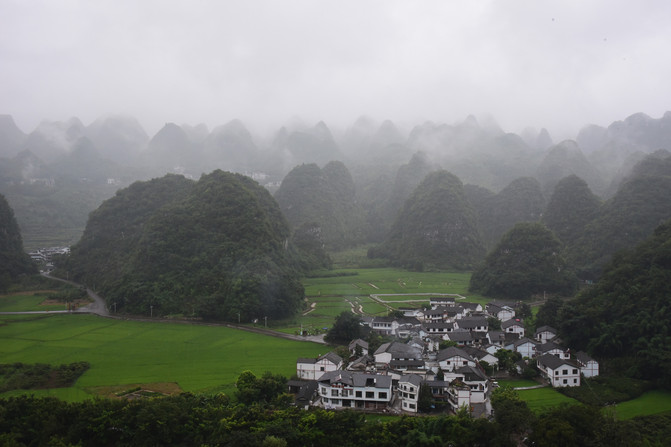


When we set foot on our way home from Xingyi, we encountered heavy rain. We looked down on the valley bottom from the Canyon Bridge. The rushing river looked like a crack in the ground. Not far away, several waterfalls hit the bottom of the valley with the momentum of tens of thousands of horses galloping, stirring up a mist and spreading the valley (Figure 23).
Wanfeng Forest has been listed on the national business card "Beautiful China" with its unique beautiful scenery of "how many mountains are in the world, but only here is a forest." On August 3, take a scenic tour bus and enter Wanfeng Forest. The beautiful mountains blend with green fields, winding rivers, simple villages, and lush forests, forming the best ecological environment in nature., forming a rare peak forest pastoral scenery (Figure 24). After watching it again, we still didn't feel enough. We drove into the villages in Wanfenglin. On the field paths, the air was filled with the refreshing fragrance of rice flowers. You should know that Guizhou is basically mountainous. This is probably the flat land where rice can be grown.
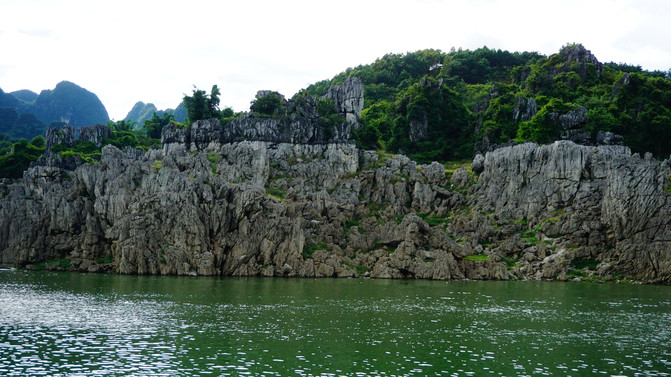
In the afternoon, we continued to climb mountains and ridges to Wanfeng Lake. What we first saw was the thousands of stalagmites. Traveling on the lake by boat, the lake is surrounded by thousands of peaks. Whether it is on the shore or on the lake, the reflection in the water is swaying and drifting, and it is like a dream.
Zhangjiajie
On the 4th, we drove from Xingyi to Kaili. The journey is long, passing world-class famous bridges such as the Beipanjiang Bridge and the Baling River Bridge, especially the Baling River Bridge in the fog of clouds and clouds (Figure 25), with thick piers and straight bridge decks, curved steel cables... with the changes of time and space, sometimes soft and sometimes masculine, as if you are in a fairyland. Without forgetting my original intention, I took the famous Anti-Japanese War Highway-24th Road (Figure 26). It was already dark when I arrived in Kaili.
On the 5th, drive from Kaili to Fanjing Mountain. Fanjing Mountain once appeared on the national business card, and the mushroom stone on the top of the mountain once appeared on the postage postcard of "Guizhou Scenery". After Fanjing Mountain was selected as a World Natural Heritage Site in 2018, tourism became popular. Tickets for Fanjing Mountain were sold out when we arrived. I could only turn around at the entrance of the scenic area, overlook the mountain peak, and imagine the mushroom stone on the top of the mountain.
After discussion, several people decided to turn to Zhangjiajie, which is known as "Three Thousand Strange Peaks and Eight Hundred Beautiful Waters". After lunch, we drove on the road and headed straight to Wulingyuan.



The natural scenery of Zhangjiajie National Park is amazing by the peaks, the valleys, and the forests. On the morning of the 6th, I first took the cableway up the mountain and visited the Tianzi Mountain Scenic Area. What came to my eye was the "Fairy Dispersing Flowers"(Figure 27) once posted on the postage postcard of "Wulingyuan". It was like a girl with flowers on her head, holding an exquisite flower basket, grabbing a handful of flowers in her right hand and sending them to the world. There are many strange peaks here, as if all the strange peaks in the world gather here. On the mountaintop observation deck, you can stand on the peak and see Yubi Peak in front of you. As a representative of the thousands of strange peaks here, it has appeared on stamps and postage maps many times (Figures 28-30).

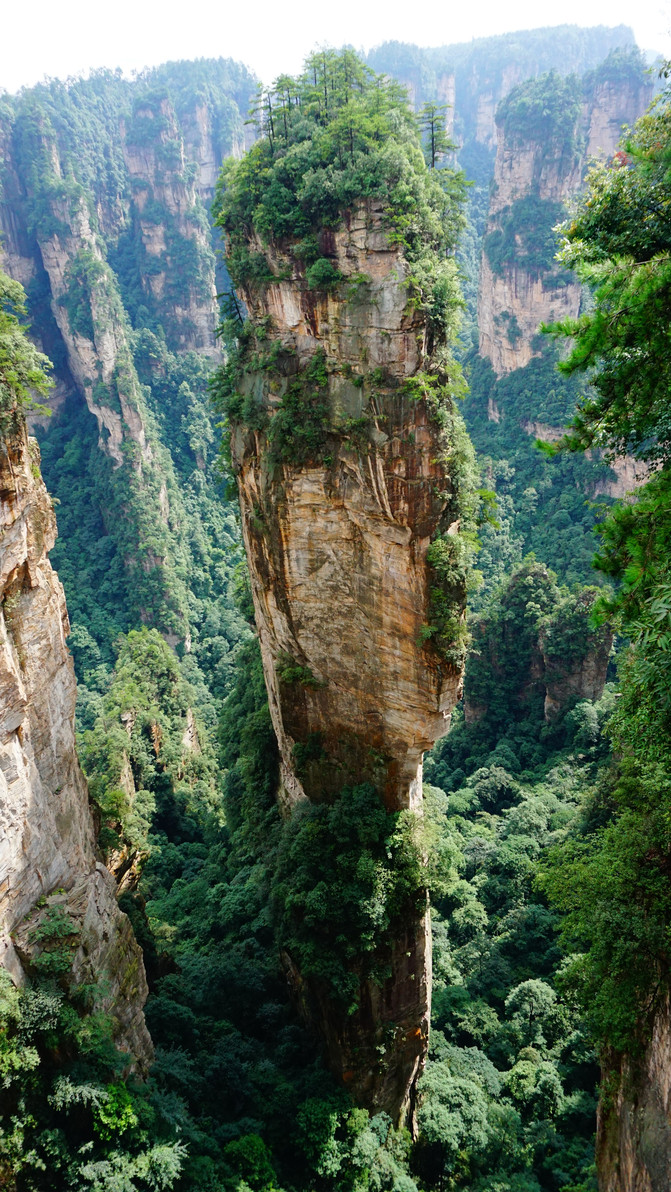

The Yangjiajie Scenic Area mainly has scenic spots such as Golden Rooster, Wulong Village, Sandao Guimen Gate, Yangmen Female Generals, Echo Wall, Valentine's Peak, Wuzhi Mountain, Tianbo Mansion, etc. Among them, the most famous bandit nest in western Hunan-Wulong Village is dangerous and easy to defend but difficult to attack, which is quite unique.
Coming down from Wulong Village, there was suddenly thunder and heavy rain fell. Take a bus to the top of the mountain to see the most bizarre and spectacular Yuanjiajie. The Yuan family world in the rain is misty and confused, like an ink landscape. After the rain, the sky is fine, and clouds and clouds are slowly rising from the valley and circling the mountain peaks. It is like a fairyland on earth (Figure 31), which makes people forget to leave. "The No. 1 Bridge in the World"(Figure 32) is the highest stone bridge in Zhangjiajie. The sky is "erected" on the two peaks, connecting the east and west peaks. The pine trees are tall and straight on the bridge, the clouds and mist ripple under the bridge, the abyss is vast, and the cliffs around it are surrounded by water droplets. Stepping on the bridge deck, I feel like I'm flying in the air. Attractions such as Qiankun Pillar, Jiutian Mysterious Ladder, Lianxin Bridge, Divine Turtle Wentian, and Ecstasy Terrace are also shocking.

Down the mountain from the Hundred Dragons Stairs in Yuanjiajie, we came to the Shili Gallery. A day's walking makes people feel exhausted, so I take the small train in the scenic area to admire the Three Sisters Peak, the elderly herb picker, the family portrait, Zhizhi Peak, Tuoluo Peak and other strange peaks. It's just that I still can't find the location of the main picture of the stamp sheetlet. Teacher Xu Yanbo, who designed this set of stamps, crossed a creek in order to check the original miniature sheetlet and found it at the cost of falling into the creek. It can be seen that they are not visible on ordinary tourist routes. I was waiting for a passing by, so I could only check in here. Later, I called on Teacher Xu to verify face-to-face. Teacher Xu told me: This is the scenery at the entrance of the scenic area. Because the stamps represent mountains, the factors of streams are specially incorporated into the sheetlet (Figure 33).
On the morning of August 7, walk into the Jinbianxi of the "Landscape Gallery". When I first entered the valley, the sun was still shining high. After walking far, I suddenly encountered a heavy rain. Tourists walked back one after another, like birds scattered. The still large valley suddenly became empty. We continued to follow the stone trail and follow the stream. Thousands of peaks stood on both sides, high into the sky; the stream was lush with trees. After traveling for about 3 kilometers, the sun squeezed out of the clouds again. The sunlight shone through the gaps between the trees and shone on the stream, projecting beams of light. The mist slowly rises from the stream, making it picturesque (Figure 34). It feels more beautiful than the picture of Jinbian Creek on the postage postcard of "Wulingyuan". Many lively monkeys are playing in the woods, some are jumping on the treetops, and some walk up to the tourists and stretch out their claws to eat. There are also naughty people who jump directly from trees into the stream to swim... adding a little fun.
Hunan's scenic post offices are quite complete. Each scenic spot has a theme post office. There is also a post office stall at the gate of Wujiayu Scenic Area to provide tourists with services such as stamping and sending postcards.
After lunch in Wulingyuan, he drove away from Zhangjiajie. Follow the Hangzhou-Ruizhou Expressway through Yueyang and Linxiang, and stay at Yinshui Family in Dafan Town, Tongshan County, Xianning, Hubei Province at 6 p.m. Although there is a 4A scenic spot nearby, I am not interested in visiting it. We continued our journey early on the 8th and returned to Ningbo smoothly in the afternoon. The endless 100,000 mountains, the thousands of peaks competing, the deep canyons, and the waterfalls that flow straight down from the rapids are endless aftertaste.
Previous Article:The east sea is dusty, the world is vicissitudes, take your children to see Zhangjiajie through the ages
